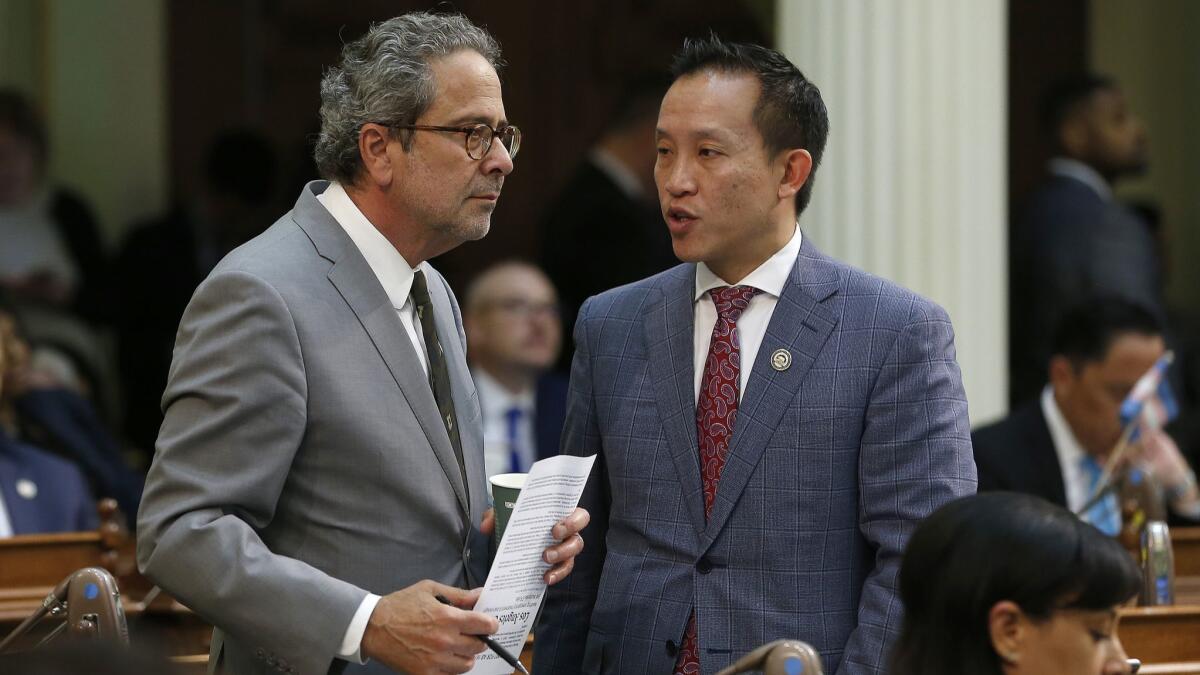How California’s big plans to address housing affordability crashed

Just over two weeks ago, California lawmakers were planning to advance some of the most aggressive policies in the nation to combat rising housing costs. They were pushing to open up most neighborhoods zoned only for single-family homes to apartment construction and to prevent millions of renters from facing double-digit rent increases each year.
Then it all fell apart.
In a series of dramatic committee hearings and last-minute decisions in Sacramento, three major housing bills were blocked or whittled to a husk. Their demise came at the hands of engaged homeowner activists from predominantly suburban communities, real estate lobbies and after a lack of intervention from Gov. Gavin Newsom and legislative leadership to keep the bills alive.
Now, after it appeared lawmakers would make their strongest attempt yet at addressing California’s housing affordability challenges, they believe their measures won’t be enough.
“We all know we have to have an appropriate crisis response,” Assemblyman Rob Bonta (D-Alameda) said after an antieviction measure he co-wrote was shelved on the Assembly floor. “We don’t have it yet.”
The state’s housing cost problems are well documented. Nine of the 15 metropolitan areas with the highest median home values in the country are in California, with those in Silicon Valley topping the list at $1.2 million, according to real estate website Zillow. Many interest groups involved in housing issues have broadly agreed that the answer should involve more homebuilding, preserving existing housing stock and advancing protections to renters vulnerable to eviction.
At the beginning of the year, it appeared support was coalescing around bills aimed at making inroads in those areas. Newsom made housing a centerpiece of his campaign in 2018, promising to more than quadruple housing production and provide stability for tenants.
Bolstering that momentum, a coalition of Bay Area city leaders, nonprofits, developers and labor groups decided to support a series of proposals to address housing problems, a previously unseen level of unity behind such a robust housing package.
But the effort split the Democratic supermajority in control of the Legislature, exposing divisions between lawmakers over how to address the rising costs.
The first major measure to meet its demise in May was Senate Bill 50, a plan by state Sen. Scott Wiener (D-San Francisco), to allow midrise apartment construction near rail stations and four or more homes on parcels of land in most single-family neighborhoods across the state. The bill attracted national attention for its efforts to spur homebuilding in communities that had already been developed and for fierce opposition from homeowners worried about changes to their neighborhoods.
Without allowing the legislation to proceed to a public vote, Sen. Anthony Portantino shelved SB 50 in the Senate Appropriations Committee he chairs. Portantino, a Democrat who represents the wealthy bedroom community of La Cañada Flintridge outside Los Angeles, has said the bill was too punitive because it took away power from cities and counties to plan for housing. A powerful bloc of community and local government activists largely from suburban areas shared Portantino’s criticisms and agitated against the bill up and down the state, and their pressure led to its failure.
The demise of SB 50 alarmed the State Building and Construction Trades Council, which represents construction workers in California. The organization was part of a broad coalition that threw its weight behind the measure, arguing it would boost the production of homes, including those for low-income residents.
After the bill was shelved, Cesar Diaz, the group’s legislative director, fired off a letter to Portantino and Senate leader Toni Atkins (D-San Diego), saying the state wouldn’t be able to put together a comprehensive housing plan without measures to increase development as robust as SB 50.
“What you see is basically how hard it is to get housing policy done in the state of California,” Diaz said in an interview.
Diaz’s letter also asked the lawmakers to support two bills aimed at preventing steep rent hikes and evictions. But soon after SB 50 failed, those measures faced their own trouble.
As of early May, Assembly Bill 1482 by Assemblyman David Chiu (D-San Francisco) included language that would have set a cap for annual rent hikes statewide at 5% plus inflation. A companion measure co-written by Bonta, Assembly Bill 1481, would have prevented landlords from evicting their tenants without first providing a reason.
Both bills faced stiff opposition from landlord and real estate interests who had helped crush a ballot initiative last November that would have allowed for the expansion of rent control statewide.
The California Apartment Assn. and the California Assn. of Realtors are big players in state politics, spending nearly $700,000 combined in lobbying, for example, in just the first four months of this year. The two groups said that the renter protection measures would stifle the homebuilding needed in California to counteract a shortage of available homes.
In response, Chiu and Bonta began to chip away at their bills. First, they agreed that their plans would expire in 2030, and the rent cap wouldn’t cover apartments built in the previous 10 years, among other changes. Then Chiu agreed to raise the rent cap to 7% plus inflation and to make the policy expire in five years. And finally, on Wednesday, just days before a legislative deadline for the bill to advance, Chiu agreed to speed up the rent cap’s expiration to three years.
That decision led the Realtors’ association to drop its opposition. Hours later, the bill squeaked through the Assembly by three votes — with 17 Democrats voting against AB 1482 or abstaining from the vote. And though Bonta had also agreed to limit his antieviction measure to three years to mirror Chiu’s bill, he ultimately didn’t bring it up for a vote in the Assembly before the deadline.
Chiu said he was elated that a rent cap would be debated in the state Senate. But the changes he was forced to accept mean that the bill won’t provide sufficient protection for renters, he said.
“I suspect that in three years we will not have solved the housing crisis completely and we will likely need to revisit this,” Chiu said the night the bill advanced.
It’s also far from a sure thing that AB 1482 will pass both houses of the Legislature by a mid-September deadline. Even though the Realtors’ group no longer opposes it, landlords still do.
The new three-year expiration date in the bill simply ensures that renter advocates will try to pass another, stronger measure, said Deb Carlton, a lobbyist for the California Apartment Assn. She said apartment developers need certainty from government agencies about rent control policies if they are going to invest in building and unless a rent cap bill comes alongside a moratorium on local rent control policies, her group will remain opposed.
The failure of SB 50 provides even less of an incentive for landlords to go along with a rent cap, Carlton said.
“Pointing all your guns at the rising of rents when you’re not solving the issue by creating more housing is just poor public policy,” she said.
Despite the setbacks, legislators and activists pushing for a big set of housing bills this year are holding out hope that one could come together. Later this month, Newsom and the Legislature must reach an agreement on a new state budget that is likely to provide more funding for low-income housing construction and other housing and homelessness programs, and money could also be used as leverage for policy changes.
And, Diaz said, some of the proposals that have been set aside could be revived.
“You still have a lot of time in this legislative session to take a bill, modify it, and actually add a lot of the components to have a good package,” he said. “It’s a work in progress.”
More to Read
Get the L.A. Times Politics newsletter
Deeply reported insights into legislation, politics and policy from Sacramento, Washington and beyond. In your inbox three times per week.
You may occasionally receive promotional content from the Los Angeles Times.







